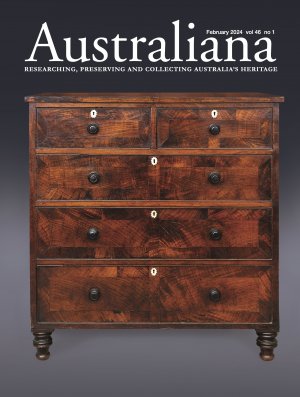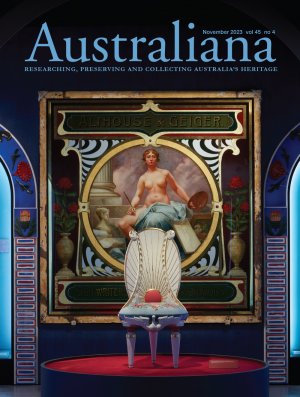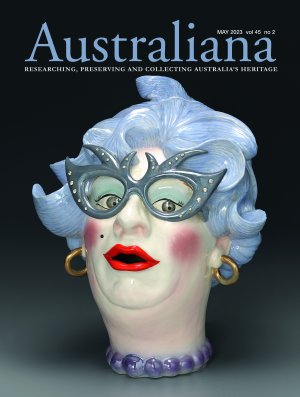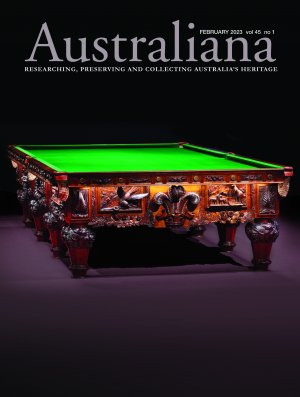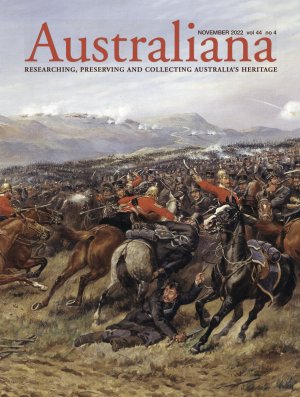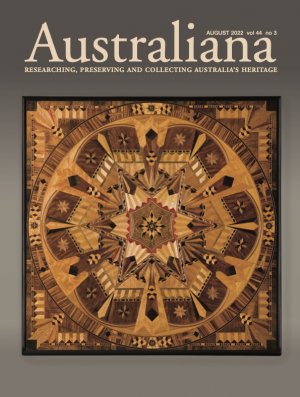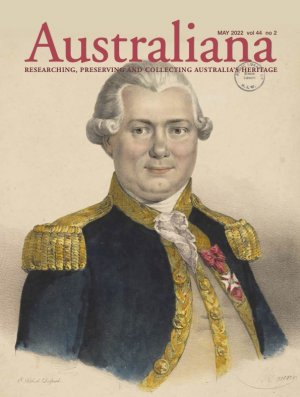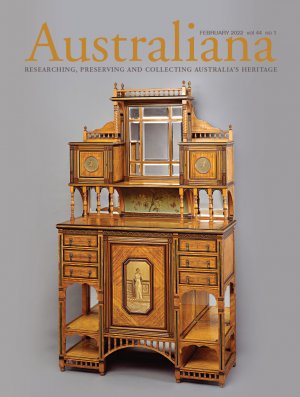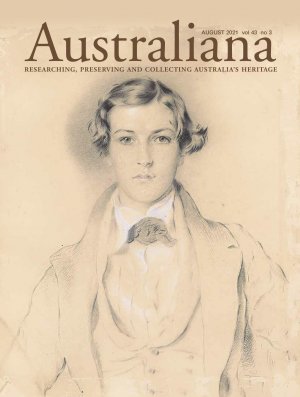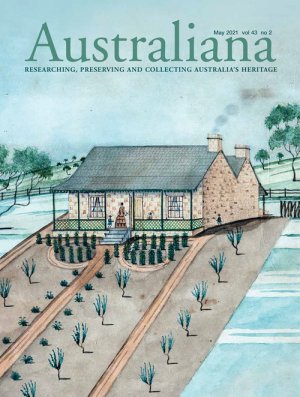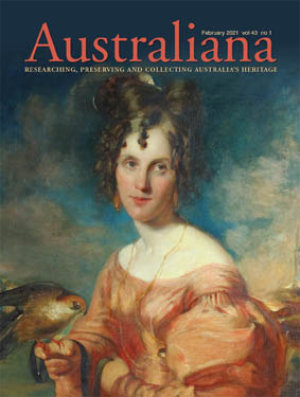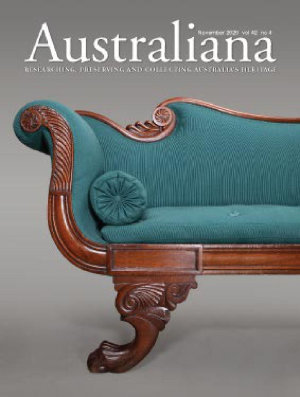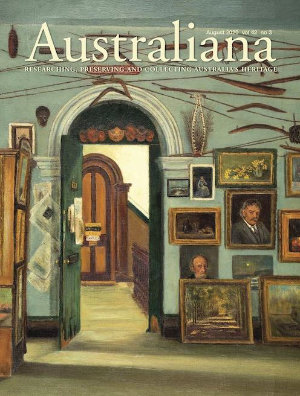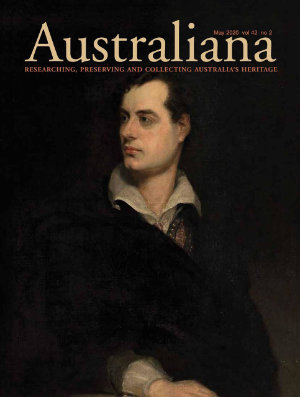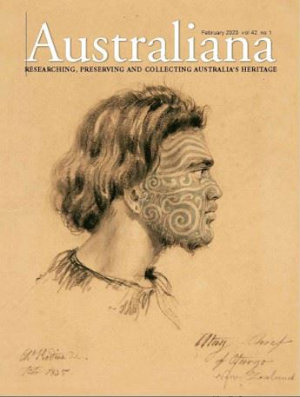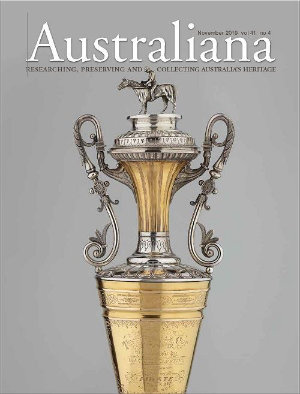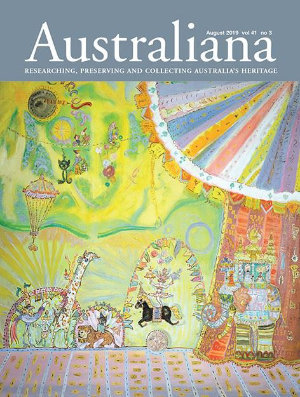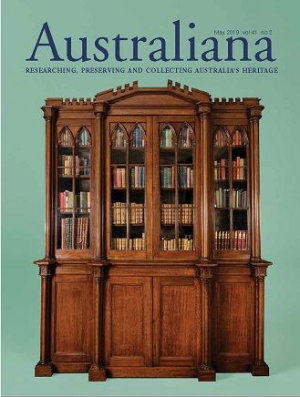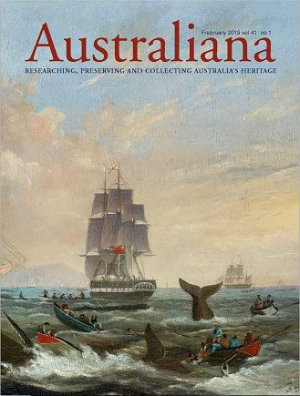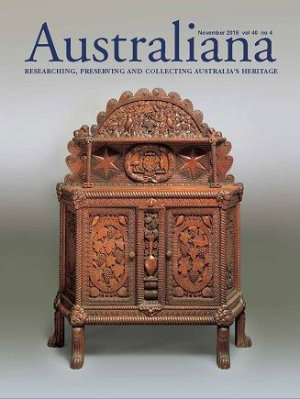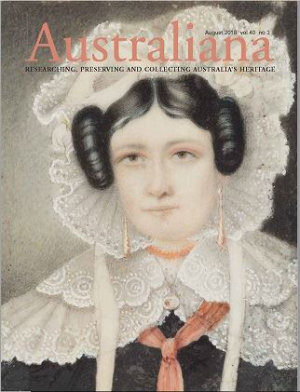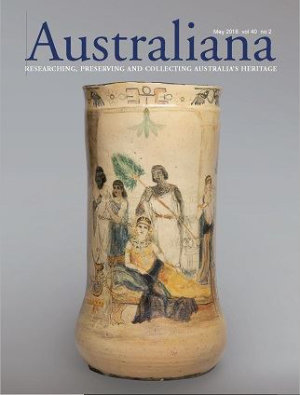Chests of drawers come in all sorts of shapes and sizes, and are easy to describe using some basic elements such as dimensions and number of drawers, types of timber, feet, knobs etc. For scholars of early furniture many more parameters come into play, not the least being an assessment of whether all its ...
An exploration into the construction and history of an early, distinctively veneered chest of drawers from Tasmania reveals that it has a twin. E.J. Bateman presents the evidence of the two chests' provenance, noting the 'broad arrow' Government inventory marks, and suggests that they were made by convict cabin...
Jewellers in colonial Australia, often lured by the gold rushes, came from various parts of Britain and Europe, arriving already
having served their apprenticeships. Teaghan Hall tells the story of several members of the Hutton family, who initially came to
the colonial Victorian...
European immigrant William Milner was a little-known entrepreneur who established a porcelain manufacturing business after
arriving in Melbourne in 1911. The porcelain industry was largely driven by a massive need for electrical insulators, and, as
COVID-19 has demons...
Bob Fredman suggests old picture frames as another area of affordable and rewarding collecting. As well as being potentially useful, these nostalgic items often have an interesting story to tell, as Bob demonstrates with these examples, all found in Queensland.
The National Museum of Australia in Canberra has purchased an Australian billiard table, carved in high relief with multiple panels of scenes of colonial life, and its matching marking board. Its price of $1,100,000 sets a new record for a piece of Australian furniture. The NMA is not known for collecting Austr...
Curator Judith McKay focuses on a unique house museum in the Northern Territory, originally planned in 1920 by the Rev. John Flynn of Flying Doctor fame as a model outback hospital. Its most remarkable feature was a passive ventilation system designed to cool the building on the Coolgardie safe princ...
Queensland collectors Jon and Yvonne Douglas explain how their collecting of Doulton ceramics developed and how, as they read more and more about their passion, their interests deepened. Here they present their research into one particular example with Australian connections, a vase made in 1886 for the Colonia...
Prodigious Australiana contributor Glenn R. Cooke is well known through his professional interests in Queensland art, decorative arts and social history. But that does not define Glenn; he loves ballroom dancing and gardens, as well as pursuing a sideline in collecting artefacts relating to his home stat...
Brisbane painter and art teacher Mary E. Jones has escaped recognition for 130 years. She would not be alone in that fate: over time, many aspiring painters and their works disappear from history. Timothy Roberts reveals some details about Miss Jones’s career and her impact as a woman artist in Brisbane betwe...
Finding more examples of the silver brooch with Indigenous motifs that she discussed in our May issue, Christine Erratt delved further into their history. In the National Archives of Australia, Christine uncovered the 1954 design registration applications.
Six different designs, of which five were inspired b...
Invented in 1948 and manufactured 'from the early 1950s, Splades or Splayds were a favourite gift for shower teas, weddings and Mothers’ Day in 1960s and 1970s Australia. We were vaguely aware that they might be an Australian innovation, but that wasn’t part of their advertising – they were prom...
Many buildings in Australia have been recognised for their architectural or historical significance, or their association with important individuals. Some have been preserved, and some have not. Jillian Dwyer relates the story of Currajong in Melbourne’s east, the Italianate villa built by the prominent colon...
We often recognise Australiana by the presence of motifs depicting Australia’s unique flora and fauna and, especially in the 19th century, representations of Indigenous figures. Anthropologists studied Indigenous people, while the things they made – much of it, what we would describe today as art – were r...
Most craftsmen who emigrated to colonial Australia were trained in the English, Scottish, Irish or German traditions. In Western Australia, several Spanish craftsmen were attracted by the monastery established by their compatriot Bendictine monks at New Norcia. Western Australian craftsmen, mostly using jarrah ...
JOURNAL REVIEW BY DR ROSS JOHNSTON, Queensland History Journal, vol. 24, no. 11, November 2021, (Journal of The Royal Historical Society of Queensland); BOOK REVIEW BY DR LINDA YOUNG, Fringe, Frog & Tassel: The Arts of the Trimmings-Maker in Interior Decoration. By Annabel Westman; BOOK REVIEW BY DR DAVID BEDF...
Dr Erickson concludes her story of the professional women artists who commenced working in Western Australia before World War I. All were born in South Australia or England, coming to Western Australia later, most as young adults and often with other family members. Their careers began in the heady years of the...
BOOK REVIEW BY PETER LANE Noris Ioannou Vernacular Visions: A Folklife History of Australia: Art, Diversity, Storytelling Wakefield Press, Mile End SA, 2021. Hard cover, 275 pp, 26 x 27 cm, RRP $79.95
Continuing our story of the women artists working in Western Australia before World War I, we will now turn to three ‘Angels’ who came, saw and conquered, but did not stay. They were all single, peripatetic, somewhat bohemian and left their mark in several societies. Marie Anne Tuck (1866–1947); Florence ...
In the 1930s, Henry McPherson, a former Clerk of the House of Assembly, told this story about William Peter Briggs, an employee of Whitesides, and the 1856 Governor’s (now President’s) Chair... This story is apocryphal. Though we normally think foremost of German immigration to South Australia, a German shi...
This darling little painting came into the possession of a friend – a friend with a very good eye. It came with no provenance, but it has since revealed a South Australian story. This is a tale of changing fortunes, one that spans the scope of Victorian society from servant, Cambridge scholar, muleteer, garde...
The State Library of New South Wales recently purchased a rare original ornithological watercolour by Elizabeth Gould (1804–1841), formerly in the collection of the late James Fairfax AC. This adds to the collection of manuscript letters and other original materials the Library has acquired relating to this i...
Mostly out of self-interest, we love to help people enhance their research skills, and thus advance knowledge of Australiana. Almost everyone will recognise themselves in this story. Art historian Stephen Scheding had lots of information on artists but needed to organise it, so he created an archive. Then he ma...
Continuing our story of the women artists who worked in Western Australia,1 we examine the careers of those who exhibited in the Paris and Glasgow international exhibitions at the turn of the century – when Western Australia was in the midst of a Gold Rush. While Lady Forrest’s work was exhibited in a separ...
When small change was hard to obtain, some merchants minted and branded their own unofficial currency. Tokens were used as normal currency, accepted by everyone everywhere until British coins became readily available. Copper ‘token’ pennies and halfpennies were circulating in all the Australian colonies in ...
Many people help create each issue of Australiana: authors, editor, photographers, owners of items, designer, expert readers, proof-readers and other talented individuals and institutions. Once we publish, each story is pretty much set in stone, so we try to check our research, facts and conclusions first. We c...
Many collectors keep up their obsession for decades, but they don’t always begin as children. Luke Jones recounts his passion for collecting Australian toys over nearly 40 years, and how he turned that into a useful and well-illustrated reference book for other collectors.
Dublin-born William Paul Dowling (c 1822–1877) worked in London as a draftsman and artist before his Irish Nationalist political activities led to his being transported to Van Diemen’s Land for sedition. Here, the Irish Catholic convict established a reputation as a portrait artist, gradually adapting to th...
Exactly 250 years ago, HMB Endeavour commanded by Lt James Cook was the first British ship to sight the east coast of Australia, then known as the Great South Land or Terra Australis Incognita. As one of the most important exploration milestones in Australia’s history, it now seems to be passing largely unnot...
Colin Thomas, Australiana Society Tasmanian Branch Chair, has assembled a scrimshaw collection with the scope and quality of institutional collections in the former whaling centres of New Bedford in Massachusetts1 and Hull in Yorkshire.2 Thomas’s collection encompasses the breadth of scrimshaw from tools to m...
In 1856, Governor Denison laid the foundation stone for Daniel Cooper's Woollahra House at Point Piper. The stone was designed to hold an engraved copper box containing coins and a medal. This box was re-used for the foundation ceremony of a later Woollahra House in 1883, and unearthed when it was demolished in...
A few years ago, I read an article in The Australian newspaper saying that future generations are at risk for being the generation that forgot history. As a mother who is an antique dealer with a passion for history, I found this a very upsetting concept. In the new world of social media – Instagram, selfies,...
David Bedford has researched the life and work of Tasmanian cabinetmaker Richard Dowling (c 1820/1822–1867), little documented till now. He presents new discoveries about Dowling’s life and suggests why Dowling’s story has been so elusive. Evidence has emerged, and examples of his work found, which show t...
Previously thought lost, this iconic Australian image – a large double-sided painted timber carving of a buck jumper made in 1893/4 by renowned Queensland sculptor Harold Parker – was made as an advertising sign for the Brisbane saddlery of R.E. Jarman. After it re-emerged in 2011 at a Sydney auction, Adam ...
Australiana is often defined by the combination of local materials, local motifs and local skills to create art that is distinctively and recognisably Australian. The Harvey School of pottery making, which flourished at the Central Technical College in Brisbane from 1916 for more than thirty years is one of the...
The Harry Gentle Resource Centre, Griffith University has welcomed specialist in Australian art heritage, decorative arts and material culture to 1945 and contributor to Australiana Timothy Roberts as the centre’s 2019 Visiting Fellow. The centre was established by Griffith University in 2016 following a gene...
Vanessa Finney, Transformations: Harriet and Helena Scott, colonial Sydney’s finest natural history painters. New South Publishing, 2018, ISBN 9781742235806, 220 pages
Dianne Byrne shares some of the outcomes of her postgraduate research into 19th-century presentation jewellery and metalwork made in Queensland or for Queenslanders, focusing here on a series of racing trophies made in the 1880s for the Tattersall’s Club Cup run at Eagle Farm racecourse. Two of these were mad...
This is the tale of a table and desk, the first an historic table made by a master craftsman who as an apprentice is reputed to have made one of Queen Victoria’s wedding presents as well as a chair presented to the Queen of Spain. This man made our table in Western Australia from native jarrah for a well-know...
As you all know we are in our 40th year and will finish our celebrations with a three-day symposium on 18–21 October 2019 at the State Library of NSW. This is going to be a very big and significant event. We have more than 25 confirmed speakers and very many different areas of Australiana will be covered in t...
This two-height cabinet (plate 1) has a capped, ogee-shaped cornice above, two glazed, veneer-bordered upper doors and two veneered panel doors below flanked by columns (plate 2), standing on a plinth. Its known provenance, as reported to me, is that it was found in Strathfield, Sydney, in the 1970s. Antique de...
The November 2018 issue featured the carved furniture of a young woman, Alice Maud Golley (1884–1961) who lived an isolated life with her immediate family on remote Wedge Island in the Spencer Gulf of South Australia. Golley’s furniture is a virtuoso display of skill and grace, yet she was untrained. Among ...
Three South Australian researchers explore the possible genesis and history of a massive red gum bookcase which came up at an Adelaide auction in 2017. Using a variety of evidence, sources and methods, they identify the bookcase as a very early piece of South Australian furniture and mount a case for who commis...
One of the first events organised by the Australiana Society’s Queensland Chapter was a visit to Miegunyah, the historic house museum owned and operated by the Queensland Women’s Historical Association in Bowen Hills, Brisbane for the past 50 years. For the visit in June 2018, local member Judith McKay acte...
In her postgraduate research into South Australian wood carvers centred on the Adelaide School of Design, Jodie Vandepeer came upon the strange story of Maud Golley (later known by her married name, Maud Baillie), a self-taught carver from remote Wedge Island, with no connection to the School. Her works exist o...
Lieutenant James Cook RN, commanding officer of HMB Endeavour, the renamed collier Earl of Pembroke, sailed on 26 August 1768 from England on a naval and scientific voyage to observe the Transit of Venus, collect natural history specimens and explore the east coast of New Holland. The 250th anniversary of the v...
Australian colonial artists sought to use local materials and to appropriate local motifs in their artworks for several reasons: to reflect the Australian origin of their work, to distinguish it from the art of other nations, and to foster a stronger sense of connection with the country. Moreton Bay pearls are ...
The Australiana Society committee recently voted to make financial grants of up to $5,000 to museums to acquire Australian-related material that they could not otherwise obtain. The Sydney Jewish Museum situated in Darlinghurst, Sydney and celebrating its 25th year in 2018, was the successful applicant for the ...
The design and manufacture of a writing desk for the Bank of New Zealand, Dunedin (1879–83). We are familiar with immigrants trained in Britain or Europe coming to Australia and continuing their craft, or with Australian artists travelling to Europe to learn and expand their skills and ideas. Rarely have we l...
“Bring forty members to Tasmania to celebrate the Australiana Society’s 40th anniversary” was president Jim Bertouch’s brief. The new Tasmanian Chapter of the Australiana Society accordingly set to work under the leadership of chairman Colin Thomas to emulate the success of the Society’s 2015 Tasmania...
